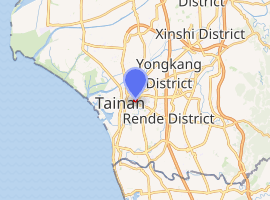Tainan Wu Garden
Tainan Wu Garden (Chinese: 臺南吳園; pinyin: Táinán Wú Yuán), known at the time of its creation as "Purple Spring Garden (紫春園)," is located in West Central District, Tainan, Taiwan (once part of Tainan (府城)'s Pang-kiô-thâu (枋橋頭) area). Built by Wu Shangxin (吳尚新), the garden is known as one of the Four Great Gardens of Taiwan (台灣四大名園)[1], along with Lin Family Mansion and Garden in Wufeng (霧峰萊園), Beiguo Garden in Hsinchu (新竹北郭園), and Lin Family Mansion and Garden in Banqiao (板橋林本源園邸),.
| Tainan Wu Garden | |
|---|---|
| 臺南吳園 | |
The sole surviving waterside pavilion at Wu Garden; the multistory building to its rear is Far East Department Store Park Branch | |

| |
| Type | Garden |
| Location | West Central, Tainan, Taiwan |
| Coordinates | 22°59′39″N 120°12′22″E |
| Created | 1828 |

History
Wu Garden was built around 1828 when salt magnate Wu Shangxin bought the garden of He Bin (何斌), an interpreter during the era of Dutch rule who played a role in the fall of Fort Zeelandia. At the time, it was also called "lâu-á lāi (樓仔內)"[1]. Alluding to the wealth of the Wu family, there was a local saying "Even if you have the wealth of lâu-á lāi, you don't own the estate of lâu-á lāi ; even if you own the estate of lâu-á lāi, you don't have the wealth of lâu-á lāi 「有樓仔內的富,也無樓仔內的厝;有樓仔內的厝,也無樓仔內的富」".[1]
During Japanese rule, when the fortunes of the Wu family began to decline, the garden was confiscated by Tainan Prefecture (臺南廳)[2]. In 1911, the Former Tainan Assembly Hall was constructed along the Garden's southern edge, as well as the then-famous Four Seasons Inn (四春園旅館) on its southeastern side, the Tainan Library (臺南圖書館) (in 1920) on its northwestern corner [3], and Tainan Municipal Swimming Pool (臺南市水浴場) (in 1922) on its northern edge[4]. In 1974, the Four Seasons Inn, Tainan Library, and Tainan Municipal Bathhouse were sold to Far East Department Store, and now is the location of its Park Branch store[4].
In 1994, there was a proposal for commercial development on the garden's grounds, but the plans were dropped and the garden has been preserved to this day[2].
See also
References
- 傅朝卿 (November 2001). 台南市古蹟與歷史建築總覽. 台南市: 台灣建築與文化資產出版社. pp. 279頁. ISBN 957-30880-4-5.
- 石萬壽 (March 2004). 樂君甲子集. 臺南市政府文化局. pp. 191、192頁. ISBN 957-01-6745-9.
- 遠流台灣館 (2003-02-01). 台南歷史深度旅遊. 台北市: 遠流出版社. pp. 52、53頁. ISBN 957-30880-4-5.
- 臺南公會堂內展出的之歷史沿革介紹
| Wikimedia Commons has media related to Wu's Garden. |